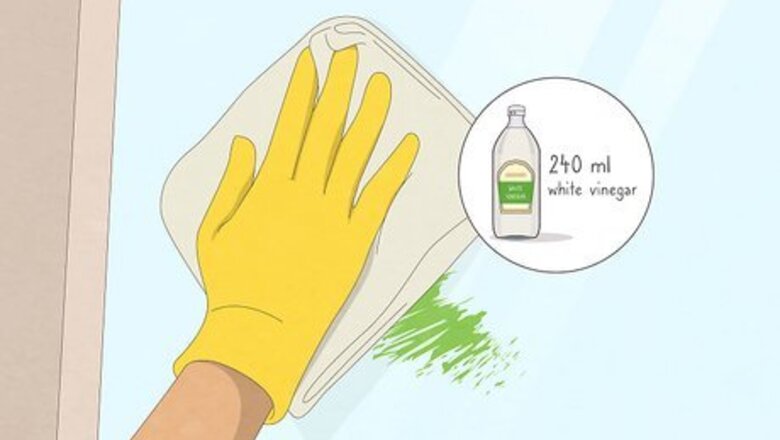
views
- Warm distilled white vinegar in your microwave and wet a cloth with it. Hold the cloth against the paint marks for a few minutes before scrubbing them away.
- Wet your window with soapy water, and hold a razor blade at an angle against the glass. Push the blade in long, straight strokes to scrape the paint away.
- Soak a clean rag in warm soapy water and press it against the paint. Scrub the paint with the cloth or plastic putty knife.
Scrub the glass with a warm vinegar solution.
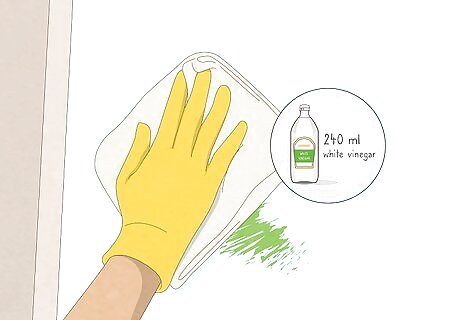
White vinegar strips any type of dried paint without using harsh chemicals. Distilled white vinegar acts as a natural paint solvent, and you probably already have it at home. As the vinegar soaks in, it loosens the paint’s bond to your window so it wipes away easily. Heat 1 cup (240 ml) of white vinegar in your microwave for about 4 minutes or until it comes to a boil. Put on thick rubber gloves and dip a clean rag into the white vinegar. Press the wet cloth against the paint stains, and scrub them off of your window. Wipe leftover paint and vinegar from your window with soapy water and a clean cloth. Want to get some additional cleaning done? Use this opportunity to also wipe your microwave since the vinegar steam will make baked-on foods easier to clean up.
Scrape off excess paint with a razor blade.

A sharp razor blade easily lifts up dried latex paint from the glass. Because a sharp razor blade sits flush against the glass, you’re able to work it under dried paint. New razors with a long, flat blade work better than older razors with dents or nicks because they’re less likely to leave scratches. Just work carefully across your window so you don’t leave any other marks on your window. Wet the window with soapy water to help lubricate the surface. Hold the razor at a 45-degree angle to the window pane. Apply firm pressure and push the blade in a smooth, slow motion toward the paint to make it lift off of the surface. Try to remove the paint so it comes away in a single piece. Avoid moving the blade back and forth since it’s more likely to etch into the glass.
Try scrubbing fresh paint with soapy water.
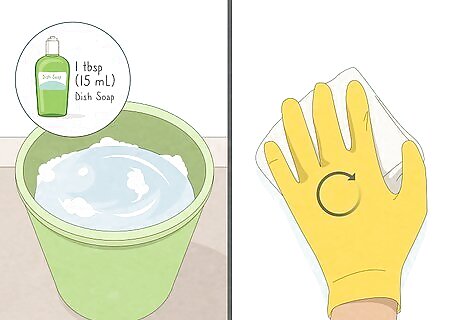
Dish soap cuts through water-based paints that are still wet on the surface. If you just finished painting and notice specks on your window, dish soap may be enough to remove the paint if you act quickly. Soapy water works best for acrylics or latex paint since they’re water-based and easier to lift up. Fill a bucket with warm water and 1 tablespoon (15 mL) of dish soap. Soak a clean rag in the soapy water and hold it against the paint. Scrub the paint using circular motions to remove it from the glass. Alternatively, try using a mixture of warm water and baby shampoo. Use a soft cloth or plastic putty knife to help scrape up any paint still on the surface.
Buff dried paint away with soapy water and fine steel wool.
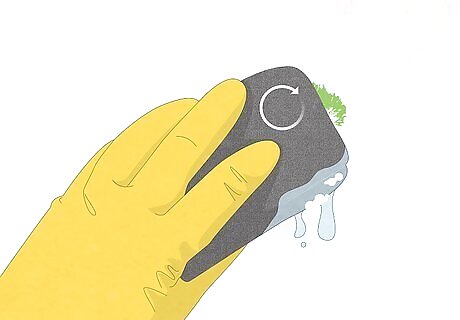
Fine steel wool breaks apart hard paint without scratching your window. While you may be hesitant to use steel wool on your window, the grit is small enough that it doesn’t leave any abrasion marks. The steel wool catches on any specks of paint stuck on the glass while you’re scrubbing, leaving behind a clean, clear finish. Wet your window with soapy water to help loosen the paint and lubricate the surface so you’re less likely to leave marks. Wet #0000 steel wool with warm water. Apply gentle pressure and scrub your window in circular motions to remove the paint residue. Wipe the soapy water off with a squeegee.
Dissolve water-based paint with rubbing alcohol.

Rubbing alcohol naturally breaks down acrylic and latex paints. While rubbing alcohol doesn’t work well for oil-based paints, it will start lifting water-based paint marks within a few minutes. Use the highest concentration of rubbing alcohol so it’s the most effective at removing the paint from your windows. Wet a clean cloth, toothbrush, or cotton swab with rubbing alcohol. Gently scrub the paint using circular motions to lift it up. Wipe the glass with standard glass cleaner to remove residual alcohol and paint.
Lift dry paint with acetone nail polish remover.

Acetone acts as a solvent for any type of wet or dry paint. While acetone is a type of chemical paint remover, it’s less aggressive than other commercial solvents. If you have some nail polish remover at home already, then grab it to clean your windows. Just be aware that acetone fumes can cause eye and lung irritation, so wear safety glasses and a face mask to reduce your exposure. Soak a clean rag or cotton ball in acetone and press it against the paint on your window. Let the acetone soak into the paint for 2–3 minutes to let it dissolve. Wipe the paint and leftover acetone away with a clean, dry cloth. Keep your rag away from heat and flames because acetone is highly flammable.
Wipe flecks of fresh paint with mineral spirits.
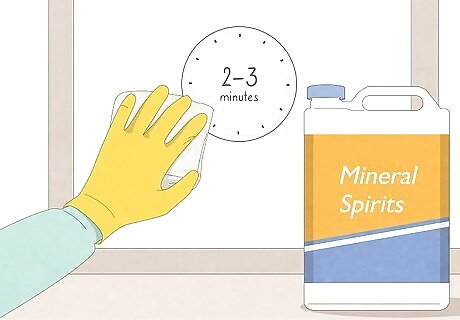
Mineral spirits thin wet paint so it’s easier to remove. Mineral spirits are more affordable and not as harsh as other paint thinners, so it’s perfect if you’re only cleaning up small paint marks. Because mineral spirits only dissolve fresh paint, use it if you just finished and the drops are still wet. Put on safety glasses, a face mask, and rubber gloves to avoid any irritation or contact with the mineral spirits. Dampen a clean rag with your mineral spirits. Hold the damp rag over the paint marks for 2–3 minutes to dissolve the paint. Wipe the surface with a clean corner of the cloth to remove the paint marks. You can buy mineral spirits at your local home improvement store. Mineral spirits are flammable, so keep them away from any heat sources or open flames.
Use turpentine on slightly-dried paint marks.
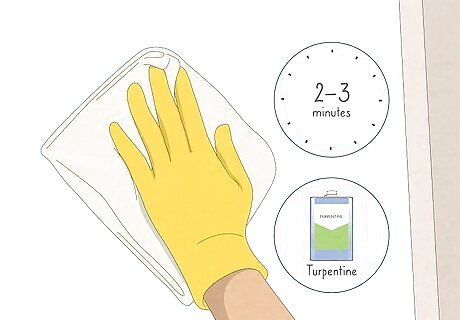
Turpentine works great for breaking down oil- and water-based paint. Turpentine is a strong solvent usually used for cleaning paintbrushes, but it also works for cleaning paint that’s started to dry but hasn’t completely hardened yet. Wear safety glasses, rubber gloves, and a respirator to protect yourself from spills and fumes. Wet a clean cloth with turpentine. Hold the cloth against the paint marks on your window for 2–3 minutes. Wipe the paint marks away with a clean cloth.
Apply paint stripper to remove dry paint from window frames
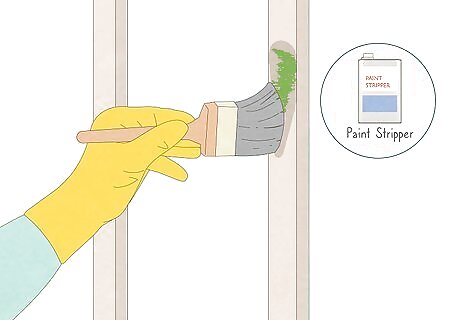
Using paint stripper on window frames removes layers of built-up paint. Solvent-based strippers work great on both wood and metal window frames because they break down the bond that is holding the paint, making it a lot easier to scrape away. If you want to repaint a window frame, paint stripper soaks through all the old layers of paint so it’s easier to scrape away. Since using paint strippers involves harsh chemicals, don your protective gear like safety glasses, respirator, and gloves so you stay protected. Remove any hardware from the frame, like nails or handles. Lay down a tarp beneath the window and move furniture out from underneath it. Dip a paintbrush into the stripper and paint a small section of the window. Let the stripper saturate the surface for about 20 minutes. Read the manufacturer’s instructions since some brands may have different instructions about timing. Use a plastic or metal scraper to remove as much of the treated paint as you can. Scrape paint out of creases and depressions with a wire brush. Use gentle motions so you don’t damage the surface. Continue applying the stripper and scraping the paint until you finish the entire frame. Wipe down the wood with a clean, wet rag. Sand the window pane with 220-grit sandpaper to work away any small scrapes and remove any tiny flecks of paint that remain.




















Comments
0 comment